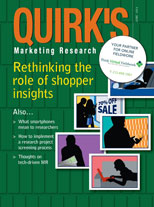Editor's note: David Conway is strategy director at the New York office of Nunwood, a Leeds, U.K., research company. He can be reached at davidconway@nunwood.com. This article appeared in the June 28, 2011, edition of Quirk's e-newsletter.
There are few companies that haven't embarked upon a program to radically improve their customer experience. However, the vast majority of these programs result in failure, with the experience of their customers remaining fragmented, inconsistent and frustrating. A study of customer experience excellence by Nunwood, a Leeds, U.K., research company, may help illustrate why.
Inextricably linked
Most companies realize that when designing effective customer processes they have to look at their organization from the customer's perspective and design the process from the outside in. However, companies that excel in delivering experiences that promote recommendation and drive loyalty are those that have realized that the customer experience, the employee experience and their organizational culture are inextricably linked. They have learned to look inside out and outside in - simultaneously.
Companies that have failed to make the Nunwood customer experience top-100 rankings tend to be the ones looking for silver bullets - the one least-effort, least-cost thing that will transform the experience. The managers of these companies approach the concept of the customer experience naively, failing to recognize that their organization is hardwired to continue to deliver the current experience based on its history, values, beliefs and rule-set.
No coincidence
USAA, Amazon, Southwest Airlines, Apple and Zappos top the rankings for the quality of their customer experiences. It is no coincidence that the CEOs of each of these companies have publicly stated that in order to put the customer first they started by putting the employee and organizational culture first. Using the study findings, Nunwood analyzed the practices of these companies to identify the best approaches to revamping the customer experience.
The knowledge audit
The knowledge audit addresses these questions: What do we know about our culture and how it impacts customers and what do we know about our customers that informs our understanding of the experience we should be delivering?
The experiences customers have with organizations are the result of complex corporate behaviors - the deeply-engrained beliefs, values, measures, management processes, written and unwritten rules that shape the employees' environment and through it the experience of the customer. Excellent organizations approach culture systematically, first identifying internal inconsistencies in delivering an outstanding experience, misaligned processes, siloed organizational structures and conflicting KPIs and incentives and then identifying the unwritten rules that truly drive organizational behavior.
Unwritten rules are unique to each organization because they operate below the surface and are rarely discussed or confronted but have a dramatic impact on the customer. These unspoken rules (i.e., always keep your boss happy; be seen to excel; always meet your KPIs; hit your targets at any cost; etc.) often drive behaviors that are anti-customer. Identifying the cultural and employee experience attributes that impact the customer experience is rare but vital to these top performers.
A single repository
Before commissioning expensive research, answer this question: What do we already know about the customer? Most organizations know considerably more about their customers than they think they do. The problem is that the knowledge is fragmented across departments, people, market research reports and procedural manuals. Creating a single repository of all things related to customers experience is a great first step.
Ask a different question
When designing customer processes most organizations start from the perspective of how they can engineer this process to sell more. Often the internal view of the customer journey is based on some form of AIDA (awareness, interest, decision, action) plan. Consequently, the process tends to be designed - logically, but incorrectly - from an inside-out perspective.
The excellent companies that ask a different question - How do we design a process that enables customers to buy more? - will be the winners in the years ahead.
